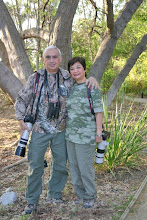Tis the season for wagtails. Everywhere we went there were wagtails. Whites and Greys at the Ecopark spillway, then Yellows at the Agripark in Los Banos. And now the tale continues again with a Grey Wagtail in Antipolo!
It was just a side-birding trip so no bazookas were brought along, only rifles, you know, just in case. Cynthia and I visited our friends, the Webbs, at their home in Palos Verdes and since we had good birding experiences in this small, forested subdivision (remember the Slaty-legged Crakes?) we thought we would just mosey around before we go home and see what birds we would find this time. There were the usual suspects of course: the Eurasian Tree Sparrows, Brown Shrikes, even some Olive-backed Sunbirds! Pied Trillers and Golden-bellied Gerygones were well represented. Zebra and Spotted Doves populated the quiet streets. A White-breasted Waterhen made a brief appearance. The White-throated Kingfisher was as skittish as usual, so unlike a completely insouciant Long-tailed Shrike that modeled for us from just a few feet away.
The real story of the day was when we saw a Grey Wagtail. The first thing that came to mind was, what was it doing here? There isn't a flowing stream anywhere nearby. Although the place was lushly wooded, we are still inside a subdivision and a house was not that far away.
Observe. Take notes.
The bird was hunting for insects close to a trickle of water flowing towards a storm drain. Looking at the bird itself we noticed that it was constantly bobbing its tail. It was brownish grey in color with a slight yellow wash underneath. A white stripe runs over its eyes and there were also some white on its wing feathers. The throat was whitish. The vent and rump areas were bright yellow. All contributing to the fact that this bird was a Grey Wagtail.
Make a sketch and show the pertinent details needed for a positive identification.
After fulfilling the duties of a puristic birder, we then turned to photography.
As bird photographers we observe and take mental notes on our subjects, too, just like any self-respecting birder. Then we document such information with the aid of pictures, showing as much as possible the colors, habits and habitats of the birds we encounter in our birding trips.
Birding and bird photography complement each other and that is an undeniable fact.
Old school birding...
1 day ago






2 comments:
I love this piece =) L.O.V.E. I love taking notes in the field and I also love looking at photographs (and dream one day I would be able to take bird photos too.) They do, and should, complement each other.
Great photos of the Wagtail. I would be lost without my camera to document what birds I see at the different sites I visit! I can't imagine how I would have managed in the days before digital photography!!
Post a Comment